Tom's Hardware Verdict
If HDR is your thing, there are few better gaming monitors than the Dell S2721DGF. Its SDR contrast is a bit lackluster, but it makes up for that somewhat with a large, accurate color gamut. With 165 Hz and two flavors of Adaptive-Sync, it delivers excellent gameplay.
Pros
- +
Excellent HDR
- +
Strong color accuracy
- +
Above average DCI-P3 color coverage
- +
Snappy, smooth gaming
- +
Good build quality
Cons
- -
Mediocre SDR contrast
- -
No sRGB mode
Why you can trust Tom's Hardware
The 27-inch,1440p gaming monitor genre is red-hot with many choices from every brand both large and small. Prices cover a relatively wide range, but after reviewing many of these screens, we’ve observed that you get what you pay for. On the north side of $500, you can expect to see refresh rates of 165 Hz and higher, AMD and Nvidia Adaptive-Sync technology, good HDR, extended color and even RGB.
The Dell S2721DGF checks all the boxes for an upper-mid priced display that can take on the best gaming monitors, and you might even be able to find it for under $500 (it's $450-$500 as of writing). The monitor's 1440p, runs at 165 Hz without overclock, has AMD FreeSync Premium Pro and G-Sync Compatibility, covers a large portion of the DCI-P3 color gamut and includes a lighting effect on the back.
Dell S2721DGF Specs
| Panel Type / Backlight | IPS / W-LED, edge array |
| Screen Size / Aspect Ratio | 27 inches / 16:9 |
| Max Resolution & Refresh Rate | 2560 x 1440 @ 165 Hz |
| Row 3 - Cell 0 | FreeSync 30-165 Hz |
| Row 4 - Cell 0 | G-Sync Compatible |
| Native Color Depth & Gamut | 10-bit (8-bit+FRC) / DCI-P3; HDR10 |
| Response Time (GTG) | 1ms |
| Brightness | 400 nits |
| Contrast | 1,000:1 |
| Speakers | None |
| Video Inputs | 1x DisplayPort 1.4 |
| Row 11 - Cell 0 | 2x HDMI 2.0 |
| Audio | 2x 3.5mm headphone output |
| USB 3.0 | 1x up, 4x down |
| Power Consumption | 32.8w, brightness @ 200 nits |
| Panel Dimensions WxHxD w/base | 24.1 x 15.3-20.5 x 7.9 inches (612 x 389-521 x 201mm) |
| Panel Thickness | 2.7 inches (68mm) |
| Bezel Width | Top/sides: 0.3 inch (7mm) |
| Row 18 - Cell 0 | Bottom: 0.7 inch (17mm) |
| Weight | 9.9 pounds (4.5kg) |
| Warranty | 3 years |
The 27-inch, 1440p genre is dominated by IPS and VA panels with a few cheaper screens going for TN technology. The S2721DGF features an IPS part with extended color and a 400-nit capable LED backlight. The monitor's native color is DCI-P3, and there's no option for the smaller sRGB color space. Color depth is 10 bits achieved with an 8-bit native panel using Frame Rate Conversion. Our banding test patterns did not show any evidence of this artifact.
The S2721DGF also supports HDR, and we found in our tests that Dell is using dynamic contrast to increase dynamic range with HDR content. Many HDR monitors today do not do the standard justice but the S2721DGF definitely does, we'll show you later on. HDR is available with both FreeSync and G-Sync Compatibility signals at maximum resolution and 165 Hz through the DisplayPort 1.4 input. Two HDMI 2.0 ports each support signals up to 144 Hz.
Assembly and Accessories
Dell continues its tradition of recyclable packaging with cleverly molded cardboard instead of foam. The panel, upright and base unpack separately and are assembled without need for tools. The S2721DGF ships with an IEC power cord for its internal power supply along with good quality HDMI, DisplayPort (see HDMI vs DisplayPort for a gaming comparison) and USB 3.0 cables.
Product 360
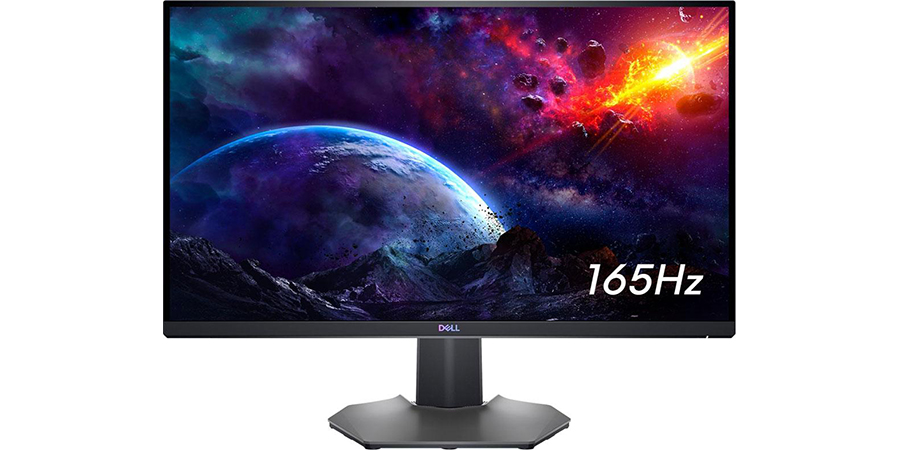

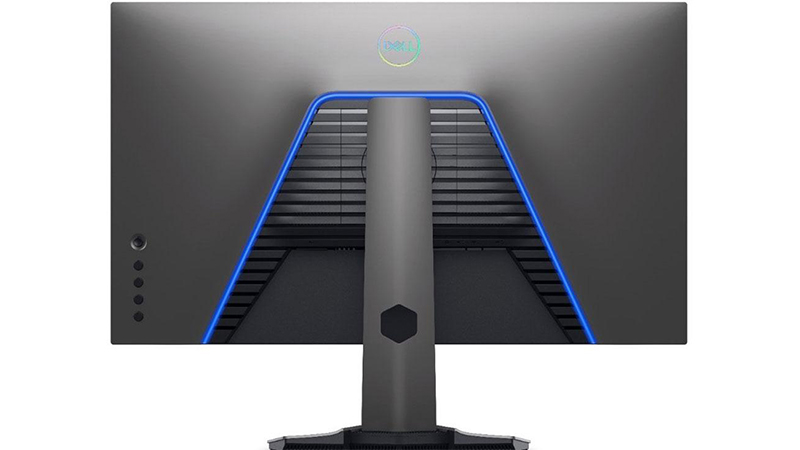
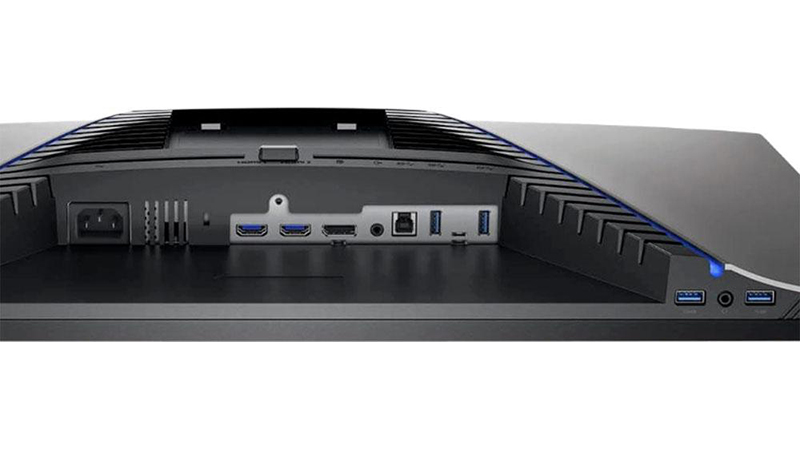
Dell tossed in a nice lighting effect in the back with an LED strip that frames a unique louvered pattern that we haven't seen before around the central mount. You don’t get a fancy light show with flashing and breathing color, but it does create a nice soft blue glow on the desktop and behind the panel.
Dell is one of the more conservative manufacturers when it comes to styling. It usually reserves the stronger aesthetic for Alienware products. But the S2721DGF is clearly a gaming monitor, even down to the base which has an interesting breakout effect where the upright appears to grow out of it.
Get Tom's Hardware's best news and in-depth reviews, straight to your inbox.
The battle for thinnest bezel continues with the S2721DGF. Its flush-mounted anti-glare layer reveals a miniscule 7mm frame when the power is on. The bottom trim is a little wider at 17mm and features a Dell logo that shimmers in different colors when light is reflected on it.
As we’ve come to expect from Dell, build quality is top-shelf, and the S2721DGF's build quality is worthy of its price tag.
The stand is very solid with no play to its full range of adjustments. The height range is just over 5 inches while swivel goes 45 degrees to either side. Tilt is 5 degrees forward and 21 degrees back, and you get a 90-degree portrait mode.
Control is via joystick and four buttons. You can see them in the side view photo, which shows a profile of just average slimness. There are no side USB ports, but Dell has placed two of them on the bottom of the bezel where they are easier to reach than the ones on the tucked-up-and-away input panel. That’s where you’ll find the other two USBs, plus two HDMI 2.0 inputs and one DisplayPort 1.4. You also get two 3.5mm audio ports; both are outputs for headphones or powered speakers. The S2721DGF does not have built-in speakers.
OSD Features of Dell S2721DGF
Pressing the S2721DGF’s joystick activates a well-designed on-screen display (OSD) with nearly every feature and option needed for quality imaging and high-performance gaming.
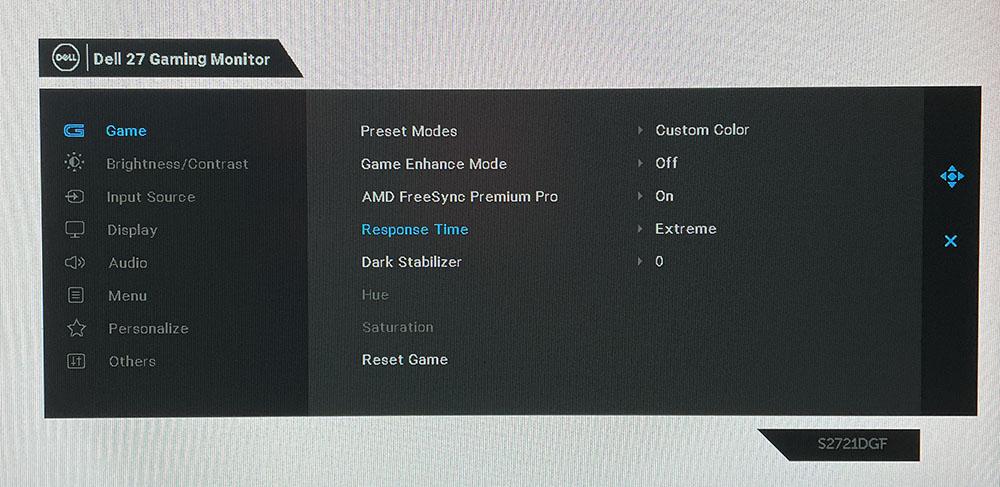
The Game menu includes 12 picture modes, four of which can be calibrated. Custom Color includes image adjustments, like white balance gain and offset, plus hue and saturation sliders. Three Game modes have the same image options, as well as overdrive and dark stabilizer settings. This lets the user create up to four different custom modes for different game and content types. Game Enhance Mode offers countdown timers, a frame counter and display alignment marks. You can toggle Adaptive-Sync on and off and choose between three overdrive levels. Extreme is the best setting for no motion blur and no ghosting. Dark Stabilizer increases the black level if you’re having trouble seeing shadow detail.

Selecting Custom Color or one of the Gaming modes takes you to an image adjust menu with gain and offset sliders for white balance and hue and saturation controls for the color gamut. The adjustments interact somewhat, so finding the ideal settings takes a little effort. We recommend calibration to dial in the grayscale tracking, but color gamut accuracy is very good out of the box. The only thing we wish for are gamma presets. Though the S2721DGF has nearly spot-on gamma at the 2.2 mark, some users prefer to choose different luminance curves.
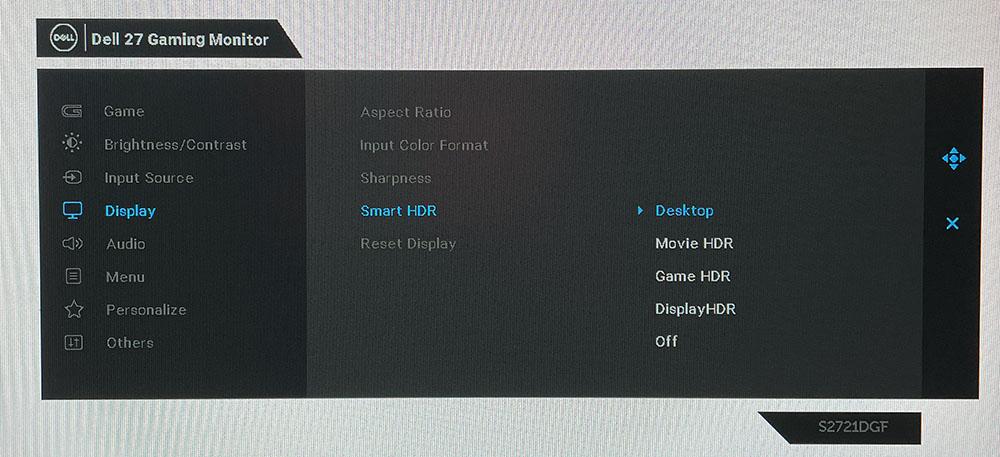
Dell offers four different HDR modes when that signal type is detected. Each delivers a different look through manipulation of color and dynamic range. Our tests showed Desktop to be the most accurate and best-looking option. Game and Movie add very obvious edge enhancement and should be avoided. DisplayHDR is similar to Desktop but with darker shadow areas that look undefined in some content.
Dell S2721DGF Calibration Settings
You can use the S2721DGF satisfactorily in its default Standard picture mode. But for optimum image fidelity, it’s best to calibrate in either Custom Color or one of the Gaming modes. There, you can tweak RGB sliders for gain and offset to achieve improved grayscale tracking. We found no benefit from the hue and saturation controls, so we suggest leaving them alone. DCI-P3 is the only color gamut available; you won't find an sRGB mode.
Our recommended settings for the Dell S2721DGF are below.
| Picture Mode | Custom Color |
|---|---|
| Brightness 200 nits | 76 |
| Brightness 120 nits | 42 |
| Brightness 100 nits | 33 |
| Brightness 80 nits | 24 |
| Brightness 50 nits | 10 (min. 31 nits) |
| Contrast | 75 |
| Gain/Bias | Gain – Red 98, Green 94, Blue 96 |
| Row 7 - Cell 0 | Bias – Red 50, Green 48, Blue 48 |
No adjustments are available for HDR signals except contrast. You can use that to dial down the brightness if you wish though we found no need to do this. Of the four HDR modes, Desktop (the default) looks and measures the best.
Gaming and Hands-on With Dell S2721DGF
Starting on the Windows desktop, it was clear that color is the S2721DGF’s strongest asset for SDR content. Thanks to a large and accurate DCI-P3 gamut with almost 93% coverage (as you'll see in our upcoming tests), every workday task was rendered in vivid hues. If you’re working on graphics and photos, you'll want to employ a color profile if you need to stay true to sRGB. The Dell S2721DGF has no option for that smaller gamut in its OSD.
SDR contrast is just OK, and there's no dynamic contrast option available in SDR mode. SDR black levels are a bit higher than most IPS panels, and because of that, the image isn’t as deep and three-dimensional as monitors like the Asus ROG Strix XG279Q.
Detail and clarity are excellent though. Pixel density is an ideal 109 pixels per inch (ppi), so you’ll have no trouble making out small text or fine textures.
Playing through various environments in Tomb Raider showed the S2721DGF’s prowess for brighter material. When moving through outdoor areas, the sunlight and other natural colors radiated from the screen.
We noticed the relatively low contrast more when exploring dark caves and building interiors. Black levels didn’t drop below a dark gray. Luckily, the gamma is very accurate, so no shadow or highlight detail is obscured.
Color was a feast for the eyes. We prefer higher contrast from a gaming monitor, but some users will be sufficiently dazzled by the Dell’s color that the high black levels won’t be a distraction.
Switching to HDR mode showed the S2721DGF’s greatest strength. With dynamic contrast in operation, black levels dropped significantly, and the monitor took on a completely different look. Outside of more premium monitors, such as those with a full-array local dimming (FALD) backlight, this is one of the best HDR screens we’ve reviewed based on observation of actual content. You’ll see on page four that it measures well too.
Every environment in Call of Duty: WWII looked amazing with contrast for days, richly saturated color and textures that were so sharp we could almost feel them. Whether the scene was dark or bright, indoors or out, it looked incredibly realistic. Color and contrast worked together in perfect balance.
Video processing was also superb. With our AMD platform, we saw frame rates between 120 and 140 frames per second (fps) with FreeSync working perfectly and blur-free operation from Dell’s excellent overdrive. We also played with G-Sync on a PC containing a GeForce RTX 3090. This card easily maxed the frame rate at 165 fps in all the games we played with detail set to maximum. Motion was almost eerily smooth with no hint of lag or stutter. The RTX 3090 may cost $1,500 (if you can find it), but it delivers amazing performance.
Despite the S2721DGF’s less than stellar SDR contrast, it provides an excellent gaming experience, thanks to its bright, saturated color and perfect video processing, plus impressive HDR image and perfect video processing. The S2721DGF is the first gaming monitor we consider better for HDR content than SDR.

Christian Eberle is a Contributing Editor for Tom's Hardware US. He's a veteran reviewer of A/V equipment, specializing in monitors. Christian began his obsession with tech when he built his first PC in 1991, a 286 running DOS 3.0 at a blazing 12MHz. In 2006, he undertook training from the Imaging Science Foundation in video calibration and testing and thus started a passion for precise imaging that persists to this day. He is also a professional musician with a degree from the New England Conservatory as a classical bassoonist which he used to good effect as a performer with the West Point Army Band from 1987 to 2013. He enjoys watching movies and listening to high-end audio in his custom-built home theater and can be seen riding trails near his home on a race-ready ICE VTX recumbent trike. Christian enjoys the endless summer in Florida where he lives with his wife and Chihuahua and plays with orchestras around the state.
